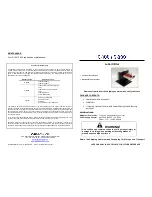
SERVICE DIAGNOSIS: Condition - Low Ice Production
I. STATUS:
EVERYTHING IS OPERATING
A. Check the condenser for dirt. Clean as required. Check the head pressure. If the head
pressure is very high:
1. Check for high air temperatures, or restrictive air flow. Correct as needed.
2.. The refrigerant may contain non condensable gases, purge, evacuate, and recharge per nameplate.
3. Check the interconnecting refrigerant tubing for kinks or twists. Check that
the discharge and liquid lines are insulated, and do not touch each other
where not insulated.
B. Check the evaporator
1. Clean the evaporator, the mineral build up will adversely affect the ice machines production.
2. Check the evaporator for water leaks, replace the water seal if found to be leaking.
3. Check the low side pressure; normal is about 30-32 psig. If low, assume a refrigerant leak, locate, repair
and recharge.
If no leak, the TXV may be restricted, defective or not adjusted properly. If needed,
replace the TXV, evacuate, and recharge per nameplate.
4. Check the insulation on the evaporator. It should be dry, with no wet spots or frost. If the insulation has
failed: replace the evaporator or add extra insulation in the form of foam tape
to the evaporator.
C. Check the compressor
1. The compressor may be inefficient.
a. Check the amp draw, normal is about 5.7 to 6.4. If low change the compressor.
b. if the amp draw is normal, pinch off the suction line to check the pull down
capability of the compressor. The compressor should pull down to 25 inches of
vacuum and hold there for three to five minutes.
D. Refrigerant charge
On this model the refrigerant charge is adequate whenever the receiver has enough liquid refrigerant to
maintain liquid refrigerant at the TXV. HOWEVER, the condensing temperature will have a definite bearing
on this. A unit with a marginal charge in summer, will be undercharged when the outside air temperature
drops. The only correct way to charge this unit is to weigh in the nameplate charge.
FME1500R
June 1994
Page 26











































